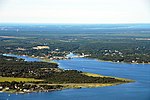Terry-Ketcham Inn

Terry-Ketcham Inn is a historic inn and tavern located at Center Moriches in Suffolk County, New York. It was built about 1693, expanded about 1710 and 1790, and is a two-story, nine-bay by two-bay frame structure with a rear wing and gable roof. The original structure was built as a two-bay by three-bay, single-story timber-frame cottage. In about 1710 a three-bay by two-bay timber frame half-house was built to the north of the original structure. A 1790 building program tripled the size of the structure.It was added to the National Register of Historic Places in 1993, and is protected by the New York State Office of Parks, Recreation and Historic Preservation. A historic barn behind the inn is used to sell books, records, and compact discs in order to raise funds for the Ketcham Inn Foundation.
Excerpt from the Wikipedia article Terry-Ketcham Inn (License: CC BY-SA 3.0, Authors, Images).Terry-Ketcham Inn
Main Street,
Geographical coordinates (GPS) Address Nearby Places Show on map
Geographical coordinates (GPS)
| Latitude | Longitude |
|---|---|
| N 40.802222222222 ° | E -72.781111111111 ° |
Address
Main Street 81
11934
New York, United States
Open on Google Maps








